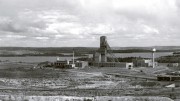The latest resource estimate for Monarch Gold’s (TSX: MQR; US-OTC: MRQRF) newly acquired Fayolle gold project in Quebec confirms the deposit’s high-grade, near-surface potential.
Fayolle’s indicated resource now stands at 706,400 tonnes grading 4.89 grams gold per tonne for 111,010 contained oz. gold.
“We are very happy with the way that Fayolle is turning out,” says Jean-Marc Lacoste, Monarch Gold’s president and CEO. “The resource estimate on the property confirms that there is a very big amount of ounces on an open-pit basis.”
The 14 sq. km Fayolle project is located 35 km northeast of Rouyn-Noranda in the townships of Aiguebelle and Cléricy.
Monarch Gold acquired a 100% interest in Fayolle in September from Hecla Mining (NYSE: HL) and Typhoon Exploration (TSXV: TYP) by issuing 12 million of its common shares to Hecla, and 3.4 million shares to Typhoon. In addition, Monarch will also pay Typhoon $1.15 million in cash.
Lacoste notes that Fayolle’s gold resource could increase as the deposit remains open at depth and along strike, and says Monarch looks at Fayolle as an open-pittable resource that fits its strategy of developing near-surface gold deposits.
Lacoste says the mine would process 70,000 oz. gold in total and that “in today’s current market, this represents revenue in excess of a hundred million dollars.”
A 2013 preliminary economic assessment estimated that a 1,000-tonne-per-day, open-pit operation would have a 36-month mine life (including one year of preproduction), based on indicated resources of 568,941 tonnes grading 4.35 grams gold per tonne for a total of 79,588 contained oz. gold.
The study calculated that the total capital cost to build a mine at Fayolle — including preproduction costs and sustaining capital, but excluding $4.4 million in closure costs — would be $5.8 million, with a two-year payback. The PEA forecast an after-tax, $17.9-million net present value at a 7% discount rate, and an after-tax, 110% internal rate of return (IRR).

Monarch Gold’s Fayolle gold project in Quebec. Photo by Typhoon Exploration.
In September, the company released assays from its 2019 diamond drilling program, which drilled 586 metres in 14 holes. Hole 19-107, which intersected the southern part of the deposit, returned 50.94 grams gold per tonne over 3 metres starting from 20 metres’ depth, including 124.08 grams gold over 1 metre.
Hole 19-103, drilled in the centre of the deposit, 25 metres northeast of hole 19-107, returned 40.5 grams gold over 5 metres from 3 metres downhole, including 132.01 grams gold over 1 metre, with multiple grains of visible gold in the sample interval. The same hole returned an assay of 8.37 grams gold over 6 metres, including 30.72 grams gold over 1 metre.
Other highlights include an interval of 43.73 grams over 5 metres contained within a broader intercept of 37.97 grams gold over 3 metres in hole 19-108, and 15.79 grams gold over 4 metres, including 31.46 grams gold over 2 metres in hole 19-109.
Siddharth Rajeev, an analyst with Fundamental Research Corp., said in a Sept. 9 research note that the latest drill results indicate strong potential for high-grade, near-surface mineralization.
With Fayolle’s latest resource estimate and assay results, Lacoste says the company will decide whether to start a feasibility study. He expects the Fayolle project could pour gold 12 to 24 months after all permitting is completed.
“It will be a permit to do a small, open-pit mine that will last only a year, maybe a year and a half,” Lacoste says.
Fayolle is one of 10 projects in the company’s pipeline.
Wasamac, Monarch’s flagship project, 15 km west of Rouyn-Noranda in Beauchastel township, is projected to produce an average of 142,000 oz. gold a year at cash costs of US$550 per oz., and all-in sustaining costs of US$630 per oz. over an 11-year mine life. Average gold metallurgical recovery is 88.2%.
Wasamac’s 2018 feasibility study tabled a $311-million net present value at a 5% discount rate and an 18.5% after-tax IRR. Initial capex is pegged at $464 million, including $230 million for the mill and tailings facility, with a 3.6-year payback. The project has measured and indicated resources of 29.9 million tonnes grading 2.7 grams gold per tonne for 2.58 million contained oz. gold.
Other advanced gold projects owned by Monarch include Croinor, Beaufor, McKenzie Break and Swanson.
The 151 sq. km, open-pit Croinor gold project, located 55 km east of Val-d’Or and 27 km east of the nearest town of Louvicourt, was the site of a past-producing mine. A January 2018 feasibility study estimated a 2.6-year mine life and average annual production of 31,472 oz. gold.
Monarch’s 5.9 sq. km Beaufor underground mine is located 20 km northeast of Val-d’Or. It has been on care and maintenance since June 2019. The company says the project has high-grade resource potential. Beaufor’s historical total production from 1939 to 1942 was 161,287 tonnes at an average grade of 7.01 grams gold per tonne for 36,342 contained oz. gold.
Monarch acquired both the McKenzie Break and Swanson properties from Agnico Eagle Mines (TSX: AEM; NYSE: AEM) in December 2017. The 3.3 sq. km McKenzie Break project hosts a high-grade gold deposit that lies 20 km north of the company’s Beacon mill and 35 km north of Val-d’Or. The 51 sq. km Swanson gold project is 65 km northeast of the city of Val-d’Or. The nearest town is Barraute, 13 km southwest.
Rajeev says Monarch Gold is following through with its plan to build a strong portfolio of early- to advanced-stage assets in the Abitibi region. He also points out that the company’s total measured and indicated resources of 3.16 million oz. and inferred resources of 1.1 million oz. imply an enterprise value of just $19 per ounce.
Lacoste says the interest for financing gold projects will rise as the gold price picks up, and breaks resistance levels.
A higher gold price is “something we were dreaming about for the last few years,” Lacoste says. “These are exciting times for companies like Monarch.”
At press time, Monarch Gold’s shares were trading at 26¢ in a 52-week trading range of 15.5¢ to 32.5¢. The company has 261 million common shares outstanding for a $68-million market capitalization.
Shareholders of the company include Hecla Mining (NYSE: HL), with 5%; Rob McEwen’s Evanachan, 4%; Oxbridge Group, 4%; and Agnico Eagle Mines, 1%. Management owns 3% of the company.






Be the first to comment on "Monarch drills visible gold at Fayolle project in Quebec"